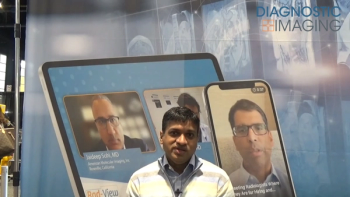
Smartphone shows images for radiologists on the go
>A new teleradiology solution takes advantage of improvements in wireless networking, imaging technology, and handheld devices to permit referring physicians to view CT and MR scans remotely on cell phones and personal digital assistants.
A new teleradiology solution takes advantage of improvements in wireless networking, imaging technology, and handheld devices to permit referring physicians to view CT and MR scans remotely on cell phones and personal digital assistants.
What sounds like a new toy for the gadget-savvy radiologist also could save the lives of stroke and heart attack patients.
"The first three hours following onset of episodes like strokes are critical, yet much of this time is spent transporting, diagnosing, and imaging the patient," said the system's developer, Dr. Neil Martin, chief of neurosurgery at the University of California, Los Angeles Medical Center.
A specialist must then be located to review the images before a treatment protocol can be determined. Martin's wireless system, the Integrated Clinical Information System (ICIS), accelerates time to treatment by transmitting diagnostic-quality images to physicians who can review studies from home, from the office, or in transit.
ICIS acquires images directly from the hospital PACS, reformats them on the ICIS server for smart-phone small screens, encrypts the data, and sends them over cellular data networks to handheld devices equipped with ICIS Mobile client software. The data are also encrypted on the mobile device.
The ICIS Mobile application currently works only on the professional edition of Windows Mobile Smartphones, although versions for Symbian, Blackberry, and the Apple iPhone are in development, according to Martin.
Managing certain medical emergencies requires more than a radiology report, he said. Stroke neurologists, neurosurgeons, intensivists, and some orthopedic surgeons want immediate image review.
"Radiology reports are sometimes not enough to enable treatment planning," Martin said. "The image is worth a thousand words from the radiologist."
ICIS has been incorporated into the first prehospital stroke study in the U.S., according to Dr. David
Liebeskind, chief of UCLA's stroke management programs.
A key element in the stroke program is the ability of physicians to instantly access vital patient data. "Gathering past diagnostic images and patient information and being able to immediately view an MR brain scan is critical to the optimal treatment of a patient with apparent emergent stroke symptoms," Liebeskind said. "Too often now you get very little information, such as 'weakness on the right side.'"
-By Douglas Page
Newsletter
Stay at the forefront of radiology with the Diagnostic Imaging newsletter, delivering the latest news, clinical insights, and imaging advancements for today’s radiologists.



























